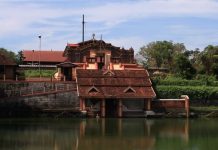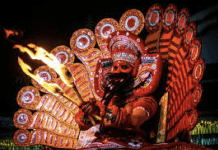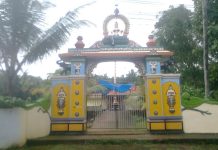Yathothkari Perumal Temple, also known as Tiruvekkaa Temple, is a Hindu temple dedicated to the Lord Vishnu, located in the city of Kanchipuram, Tamil Nadu. The presiding deity Lord Vishnu is worshipped as Yathothkari Perumal, and his consort Goddess Lakshmi as Komalavalli. This temple is one of the 108 Divya Desams dedicated to Lord Vishnu and is considered to be one of the three oldest Vishnu temples in Kanchipuram. In this article, we’ll explore the history, architecture, festivals, temple openings, and how to reach Yathothkari Perumal Temple.
Legend of Yathothkari Perumal Temple
According to Hindu mythology, there was a disagreement between Goddess Saraswati and Goddess Lakshmi, the consorts of Lord Brahma, about who was superior. They consulted Indra, the king of celestial beings, who chose Lakshmi as the superior one. Dissatisfied with this decision, Saraswati approached Brahma, who also chose Lakshmi. Disheartened, Saraswati decided to distance herself from Brahma. Brahma then performed a penance and an Ashvamedha yagna to appease Vishnu, but Saraswati was still angry, and she tried to disturb the ceremony. Vishnu intervened and forced Saraswati to concede defeat, and she transformed into the river Vegavathi. The river’s path was blocked by Vishnu, leading to the name Vegasetu, which eventually became Vekka, the name of the presiding deity.
According to another legend, Sage Bhargava had a stillborn child, believed to be a divine incarnation of Vishnu’s weapon, the Chakra. By the grace of Vishnu and Lakshmi, the baby was revived and left under the care of a childless farmer couple, who named him Sivavakkiyar. When he grew up, Sivavakkiyar was undecided about choosing between Shaivism and Vaishnavism. He was defeated in an argument by Pey Alvar and became a devotee of Vaishnavism. Sivavakkiyar was also known as Bhakthisarar and later as Thirumalisai Alvar.
Thirumalisai had a disciple named Kanikkannan, and an old lady served him. By praying to the presiding deity, Bhujangasayana Perumal, Thirumalisai transformed the old lady into a beautiful young lady. The king of Pallava, who ruled the region, fell in love with her and married her. As time passed, the king grew old, but the lady remained young. The king asked Kanikannan to sing his praises so that he too could become young. When Kanikannan refused, the king banished him from the country. Thirumalisai prayed to Bhujangasayana Perumal, and the king was eventually convinced to let the three return. As a result, the presiding deity became known as Yathothkari Perumal, meaning the one who fulfills requests. Poigai Alvar, one of the poet saints of the 7th-10th centuries, was born in this temple.
History of Yathothkari Perumal Temple
Yathothkari Perumal Temple has been glorified in the Naalayira Divya Prabandham, the early medieval Tamil canon of the Alvar saints from the 6th–9th centuries CE. The temple has 12 inscriptions from the Chola and Vijayanagara periods, providing historical evidence of its existence. The temple is believed to have been built by the Pallavas of the late 8th century AD, with later contributions from Medieval Cholas and Vijayanagara kings.
The temple has several inscriptions associated with the Chola period. One such inscription from the time of Parantaka I (907-950 CE) indicates the gift of 367 kalanju of gold to the temple by an individual. Other inscriptions from the period of Rajendra Chola I (1012-1044 CE) indicate gifts of land and gold to the temple, while inscriptions from the time of Kulothunga Chola I (1070-1120 CE) indicate a gift for lighting lamps of the temple. The southern side inscriptions of the temple from the period of Kulothunga Chola III (1178-1218 CE) indicate a gift of a village to feed 32 Brahmins.
Architecture of Yathothkari Perumal Temple
Yathothkari Perumal Temple was constructed in the Dravidian style of architecture. The temple is built on an elevated platform, which is accessed through a flight of steps. The temple’s main sanctum sanctorum is rectangular in shape and is located at the center of the platform. The temple has a tall three-tiered rajagopuram (gateway tower) at the entrance, which is intricately carved with sculptures and figures from Hindu mythology.
The temple’s Mahamandapam and Ardhamandapam are two pillared halls that are used for conducting religious ceremonies and gatherings. The Mahamandapam has ornamental sculpted pillars that are built during the Vijayanagara period of the 15th and 16th centuries. The sanctum sanctorum has a unique stucco image of the presiding deity, Ranganatha, recumbent on his left hand. This is a rare representation of the deity, as in most other temples, he is depicted lying on his right.
The temple also has separate shrines for other deities, such as Poigai Alvar, Rama, Seetha, Hanuman, Garuda, and Komavalli, the consort of Yathothkari. The temple’s lotus tank, where Poigai Alvar was born, is located outside the main entrance, parallel to the shrine.
Overall, the Sonnavannam Seitha Perumal Temple’s architecture is a blend of ancient Pallava and Chola styles, with contributions from the Vijayanagara period. The temple’s intricate carvings, ornamental pillars, and unique stucco image of the presiding deity make it a must-visit destination for those interested in Indian temple architecture.
Festivals at Yathothkari Perumal Temple
The temple celebrates several festivals throughout the year. One of the major festivals is Brahmotsavam, which is celebrated during the Tamil month of Panguni (April – May). During this festival, various rituals are performed and the temple deity is taken out in a grand procession. Aipassi Thiruvonam, which falls on the birth star of Poigai Alvar, is also celebrated annually.
In addition, there is a festival called Alvar Utsavam, which is celebrated every year on the birth date of Poigai Alvar based on the Tamil calendar. Another significant festival is the Thai Magam festival, celebrated during the Tamil month of Thai (January – February). During this festival, the festive image of Yathothkari, Tirumalisai Alvar, and Kanikkannan are taken in a procession to Orikkai village where they stay for a short period, symbolizing the legend of Kanikannan.
Temple Openings
Yathothkari Perumal Temple is open from 6:00 AM to 12:30 PM and 4:00 PM to 8:30 PM every day.
How to Reach Yathothkari Perumal Temple
The temple is located in Kanchipuram, Tamil Nadu, and is easily accessible by road, rail, and air.
By Air
The nearest airport is Chennai International Airport, which is located about 68 km from Kanchipuram.
By Rail
The nearest railway station is the Kanchipuram Railway Station, which is about 3 km away from the temple.
By Road
The temple is located in the heart of the city, and there are several buses and taxis available to reach the temple.
























































